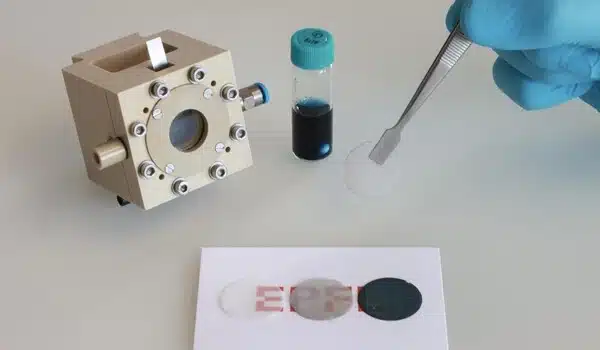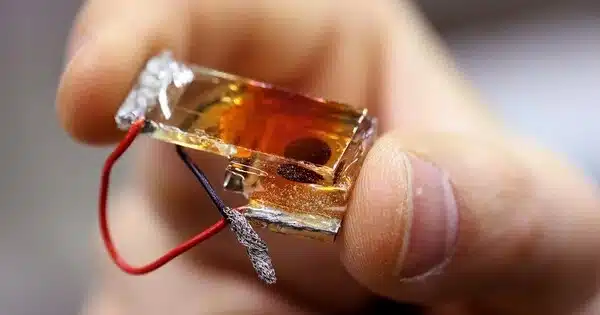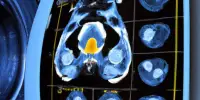The goal of solar fuels, sometimes referred to as sun-to-fuel technologies, is to capture renewable solar energy and transform it through induced photosynthesis or other methods into chemical fuels like hydrogen or hydrocarbons. Using solar-powered water splitting is a promising first step towards producing solar fuels.
A solar-powered artificial leaf created by chemical engineers is supported by a new transparent, porous electrode that can collect atmospheric water and turn it into hydrogen fuel. The technique based on semiconductors is adaptable and simple to set up.
For decades, researchers have wished for a gadget that can gather water from the air and produce hydrogen fuel while being totally driven by solar energy. Kevin Sivula, an EPFL chemical engineer, and his team have taken an important step towards making this vision a reality.
They have created an inventive yet simple system that combines semiconductor-based technology with unique electrodes that have two crucial characteristics: they are porous, allowing for maximum contact with water in the air, and transparent, allowing the semiconductor coating to be exposed to sunlight. Simply exposing the device to sunlight causes it to absorb water from the air and make hydrogen gas. The findings will be published in Advanced Materials.
We need ways to store renewable energy as chemicals that can be used as fuels and feedstocks in industry in order to realise a sustainable society. Solar energy is the most abundant form of renewable energy, and we are working to develop economically competitive ways to produce solar fuels.
Kevin Sivula
What’s new? It’s their novel gas diffusion electrodes, which are transparent, porous and conductive, enabling this solar-powered technology for turning water – in its gas state from the air — into hydrogen fuel.
“We need ways to store renewable energy as chemicals that can be used as fuels and feedstocks in industry in order to realise a sustainable society. Solar energy is the most abundant form of renewable energy, and we are working to develop economically competitive ways to produce solar fuels,” says Sivula, main investigator of the study and director of EPFL’s Laboratory for Molecular Engineering of Optoelectronic Nanomaterials.
The process of splitting water molecules (H2O) into hydrogen (H2) and oxygen (O2) is known as solar-driven water splitting. Hydrogen can then be used as a clean, efficient fuel in a variety of applications such as power generation, transportation, and industrial activities.

Inspiration from a plant’s leaf
The EPFL engineers, in conjunction with Toyota Motor Europe, were inspired by the way plants turn sunlight into chemical energy by using carbon dioxide from the air in their research for renewable fossil-free fuels. A plant takes carbon dioxide and water from its surroundings and, with the help of sunshine, can convert these molecules into sugars and starches, a process known as photosynthesis. The energy from the sun is stored in the sugars and starches as chemical bonds.
The transparent gas diffusion electrodes developed by Sivula and his team, when coated with a light harvesting semiconductor material, indeed act like an artificial leaf, harvesting water from the air and sunlight to produce hydrogen gas. The sunlight’s energy is stored in the form of hydrogen bonds.
Instead of using standard layers that are opaque to sunlight to construct electrodes, they use a 3-dimensional mesh of felted glass fibres.
“Developing our prototype device was challenging because transparent gas-diffusion electrodes had not previously been demonstrated, and we had to develop new procedures for each step,” explains Marina Caretti, lead author of the paper. However, because each process is very straightforward and scalable, I believe our technique will open up new possibilities for a wide range of applications, beginning with gas diffusion substrates for solar-powered hydrogen synthesis.”
From liquid water to humidity in the air
Sivula and other research groups have already demonstrated that artificial photosynthesis is possible by creating hydrogen fuel from liquid water and sunlight using a device known as a photoelectrochemical (PEC) cell. A PEC cell is a device that uses incident light to excite a photosensitive material, such as a semiconductor, immersed in liquid solution, resulting in a chemical reaction. However, for practical purposes, this approach has drawbacks, such as the difficulty of producing large-area PEC devices that employ liquid.
Sivula wanted to show that the PEC technology can be adapted for harvesting humidity from the air instead, leading to the development of their new gas diffusion electrode. Electrochemical cells (e.g. fuel cells) have already been shown to work with gases instead of liquids, but the gas diffusion electrodes used previously are opaque and incompatible with the solar-powered PEC technology.
Now, the researchers are focusing their efforts into optimizing the system. What is the ideal fiber size? The ideal pore size? The ideal semiconductors and membrane materials? These are questions that are being pursued in the EU Project “Sun-to-X,” which is dedicated to advance this technology, and develop new ways to convert hydrogen into liquid fuels.
Making transparent, gas-diffusion electrodes
The researchers begin with a sort of glass wool that is essentially quartz (also known as silicon oxide) fibres and turn it into feeling wafers by fusing the fibres together at high temperatures to create transparent gas diffusion electrodes. The wafer is then covered with a transparent thin coating of fluorine-doped tin oxide, which is known for its outstanding conductivity, resilience, and simplicity of scaling-up.
These initial procedures produce a translucent, porous, and conducting wafer, which is critical for maximising interaction with water molecules in the air and allowing photons to pass through. The wafer is then coated once more, this time with a thin sheet of semiconductor compounds that absorb sunlight. This second thin coating still lets light through, but appears opaque due to the large surface area of the porous substrate. As is, this coated wafer can already produce hydrogen fuel once exposed to sunlight.
The scientists then constructed a small chamber to house the covered wafer, as well as a membrane to separate the created hydrogen gas for measurement. When their chamber is exposed to sunlight under humid conditions, hydrogen gas is created, proving the scientists’ goal of developing a transparent gas- diffusion electrode for solar-powered hydrogen gas production.
While the scientists did not conduct a thorough analysis of the solar-to-hydrogen conversion efficiency in their presentation, they concede that it is modest for this prototype and is now less than that of liquid-based PEC cells. Based on the materials used, the maximum theoretical solar-to-hydrogen conversion efficiency of the coated wafer is 12%, whereas liquid cells have been demonstrated up to 19% efficient.














